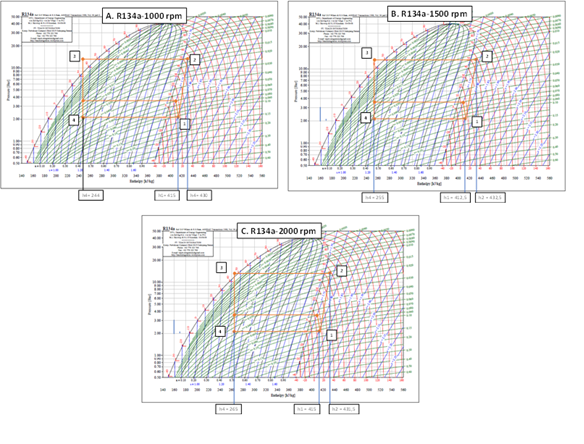Main Article Content
Abstract
The development of vapor compression refrigeration systems currently depends on the issue of environmental problems related to ozone layer depletion (ODP) and global warming potential (GWP). In addition to environmental issues, low energy use is also in the spotlight of researchers. To solve the problem of refrigeration development, natural refrigeration, especially hydrocarbons, is the focus of attention. Hydrocarbons are refrigerants that have excellent properties to be natural refrigerants. This study aims to compare the performance of refrigerant R-134a with R-290. The research used a standard vapor compression refrigeration system with a TEV-type expansion valve. The system performance is seen through compression, refrigeration effect, and COP with variations in compressor rotational speed of 1000 rpm, 1500 rpm, and 2000 rpm. The results showed that the compression work, refrigeration effect, and coefficient of performance (COP) of R-290 had a more excellent value. R-290 produces the highest compression work at a 2000 rpm compressor speed of 33.34 kJ/kg for the refrigeration effect at 1000 rpm of 353.33 kJ/kg and COP at 1500 rpm 12.32.
Keywords
Article Details
References
- Almeida, I. M. G., Barbosa, C. R. F., & Fontes, F. A. O. (2010). Thermodynamic and Thermophysical Assessment of Hydrocarbons Application in Househould Refrigerator. Revista de Engenharia Térmica, 9(1–2), 19. https://doi.org/10.5380/reterm.v9i1-2.61926.
- Bell, I. H., Domanski, P. A., McLinden, M. O., & Linteris, G. T. (2019). The hunt for nonflammable refrigerant blends to replace R-134a. International Journal of Refrigeration, 104, 484–495. https://doi.org/10.1016/j.ijrefrig.2019.05.035.
- Bolaji, B. O. (2020). Theoretical assessment of new low global warming potential refrigerant mixtures as eco-friendly alternatives in domestic refrigeration systems. Scientific African, 10, 1–11. https://doi.org/10.1016/j.sciaf.2020.e00632.
- Cai, D., Hao, Z., Xu, H., & He, G. (2022). Research on flammability of R290/R134a, R600a/R134a and R600a/R290 refrigerant mixtures. International Journal of Refrigeration, 137(February), 53–61. https://doi.org/10.1016/j.ijrefrig.2022.02.015.
- Chen, Q., Yan, G., & Yu, J. (2017). Performance analysis of an ejector enhanced refrigeration cycle with R290/R600a for application in domestic refrigerator/freezers. Applied Thermal Engineering, 120, 581–592. https://doi.org/10.1016/j.applthermaleng.2017.04.027.
- Concerns, C. (1999). Safe Conversion and Servicing Practices for Refrigeration Appliances using Hydrocarbon Refrigerants. ECOFRIG.
- Dalkilic, A. S., & Wongwises, S. (2010). A performance comparison of vapour-compression refrigeration system using various alternative refrigerants. International Communications in Heat and Mass Transfer, 37(9), 1340–1349. https://doi.org/10.1016/j.icheatmasstransfer.2010.07.006.
- Huang, Y., Wu, X., & Jing, J. (2022). Research on the electric vehicle heat pump air conditioning system based on R290 refrigerant. Energy Reports, 8, 447–455. https://doi.org/10.1016/j.egyr.2022.-05.112.
- Jones, A., Wolf, A., & Kwark, S. M. (2022). Refrigeration system development with limited charge of flammable Refrigerant, R-290. Thermal Science and Engineering Progress, 34(July), 101392. https://doi.org/10.1016/j.tsep.2022.101392.
- Kumbhar, S. V., Husainy, A., Jadhav, M. A., & Bardiya, S. G. (2023). Experimental investigations of vapour compression refrigeration system using electrohydrodynamic (E.H.D.) effect. Materials Today: Proceedings, 72, 1877–1881. https://doi.org/10.1016/j.matpr.2022.10.048.
- Martinho, G., Castro, P. J., Santos, P., Alves, A., Araújo, J. M. M., & Pereiro, A. B. (2022). Environmental behaviours and risk perception of domestic consumers: Refrigeration equipment case study. Cleaner Production Letters, 3(November), 100024. https://doi.org/10.1016/j.clpl.2022.100024.
- McLinden, M. O., Kazakov, A. F., Steven Brown, J., & Domanski, P. A. (2014). A thermodynamic analysis of refrigerants: Possibilities and tradeoffs for Low-GWP refrigerants. International Journal of Refrigeration, 38(1), 80–92. https://doi.org/10.1016/j.ijrefrig.2013.09.032.
- Ozsipahi, M., Kose, H. A., Kerpicci, H., & Gunes, H. (2022). Experimental study of R290 / R600a mixtures in vapor compression refrigeration system. International Journal of Refrigeration, 133(October 2021), 247–258. https://doi.org/10.1016/j.ijrefrig.2021.10.004.
- Poggi, F., Macchi-Tejeda, H., Leducq, D., & Bontemps, A. (2008). Refrigerant charge in refrigerating systems and strategies of charge reduction. International Journal of Refrigeration, 31(3), 353–370. https://doi.org/10.1016/j.ijrefrig.2007.05.014.
- Purnomo, B. C. (2015). Analisa Performa Sistem Refrigerasi Kompresi Uap Dengan Refrigeran Campuran Musicool Dan Co2 Aplikasi Ac Mobil [Universitas Gadjah Mada Yogyakarta]. http://etd.repository.ugm.ac.id/penelitian/detail/80762.
- Purnomo, B. C., & Setiyo, M. (2017). Karakteristik Sistem Refrigerasi Kompresi Uap Dengan Refrigerant Campuran Musicool 134 - Co2. Jurnal Teknologi, 9(2), 57. https://doi.org/10.24853/jurtek.9.2.57-64.
- Qian, Y., Sun, S., Ju, D., Shan, X., & Lu, X. (2017). Review of the state-of-the-art of biogas combustion mechanisms and applications in internal combustion engines. Renewable and Sustainable Energy Reviews, 69(October 2015), 50–58. https://doi.org/10.1016/j.rser.2016.11.059.
- Saksono, P., & Gunawan. (2019). Penggunaan Refrigeran Hidrokarbon ( HCR ) Sebagai Refrigeran Alternatif. Seminar Nasional Inovasi Dan Aplikasi Teknologi Di Industri, 321–326.
- Soni, S., Mishra, P., Maheshwari, G., & S.Verma, D. (2022). Comparative energy analysis of R1234yf, R1234ze, R717 and R600a in Vapour Compression Refrigeration system as replacement of R134a. Materials Today: Proceedings, 56, 1600–1603. https://doi.org/10.1016/j.matpr.2022.-03.206.
- Yan, G., Cui, C., & Yu, J. (2015). Energy and exergy analysis of zeotropic mixture R290/R600a vapor-compression refrigeration cycle with separation condensation. International Journal of Refrigeration, 53, 155–162. https://doi.org/10.1016/j.ijrefrig.2015.01.007.
